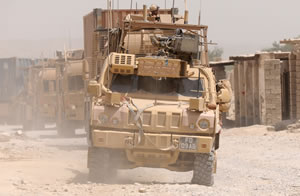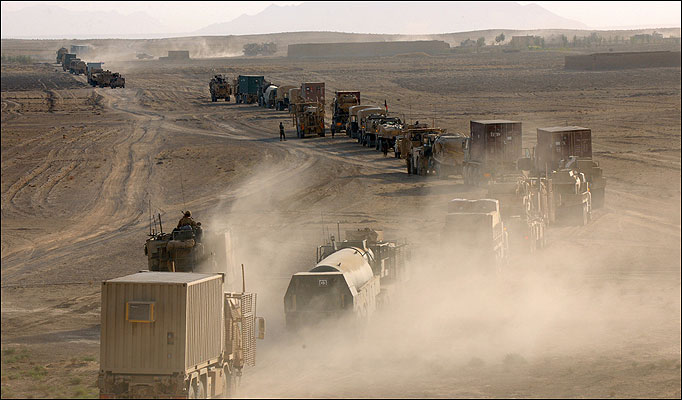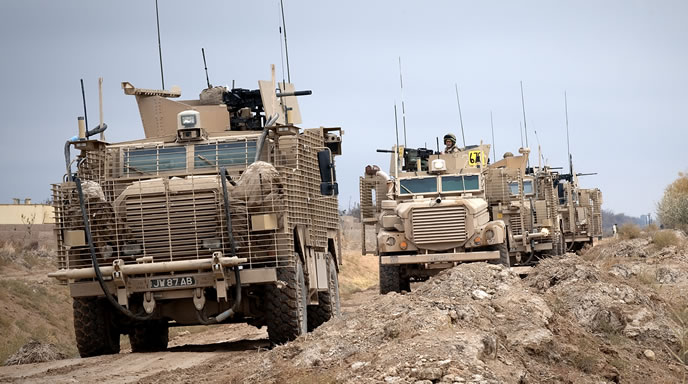Afghanistan is taking a heavy toll on the military resources of U.S. and NATO allies sharing the ISAF missions in that country. According to a recent report published by the Times of England, despite the U.K. Ministry of Defence (MOD) investment of over two billion US$ acquiring hundreds of protected vehicles in the past two years, about half of the armored vehicles used by the British Army in Afghanistan are ‘unfit for operational use’. The report refers to all the armored vehicles used by the Brits, from the lightly protected British built Land Rover based Snatch patrol vehicles to the massive U.S. built, Mine-Resistant Ambush Protected (MRAP) – the Mastiff and Ridgeback, based on the U.S. built Cougar.

The MOD acquired hundreds of Mastiff and Ridgback vehicles since 2007, the Urgent Operation Requirements (UOR). According to the report, the MOD ordered 350 Cougar-based MRAP Mastiff vehicles since 2007, of which 271 have been delivered, but after a mere six months, less than half remained operational. Combat damage, primarily by insurgent roadside improvised explosive devices (RSIED), and operational wear caused by the harsh environment, topography and climate of Afghanistan, caused premature wear, and required major repairs and refurbishment. The British forces in Afghanistan have also received 118 lighter Ridgeback vehicles. These vehicles are better designed for the Afghan theater, demonstrated slightly improved performance, with 61% being operational available. It should be mentioned that some of the Mastiffs were transferred to Afghanistan in June 2009 after extensive use in Iraq, as the British forces pullout out from Basra. Currently deployed in AFghanistan is the improved Mastiff 2 – the vehicles, have been given a number of upgrades, including: improved axles and suspension to cope with the difficult terrain; better thermal imaging for the drivers; explosive attenuating seats to provide better protection to the soldier on impact; improved armor and greater crew capacity.

Being the only platforms capable of providing effective, protective mobility, MRAP vehicles were over-tasked with tactical patrols, convoy escort and logistical support. As more MRAP vehicles are being delivered, and new tactical support vehicles introduced in theater, the situation should improve. Among the tactical support vehicles soon to arrive in Afghanistan are the Wolfhound – MRAP based tactical support vehicle and the all-terrain Coyote. MOD is also sending the Husky, a highly protected tactical utility vehicle.
In the second half of 2009 the British forces were continuously engaged in combat around the Helmand and Kandahar area of southern Afghanistan, actions that have caused significant combat losses. British casualties soared to 76 killed and 379 wounded in action, during the past six months. According to the report, the extensive activity took its toll in material as well, particularly the heavy Mine Resistant Ambush Protected Mastiff, which was not designed for the rough terrain and off-road conditions of Afghanistan. While armor protection could not eliminate combat losses, lacking of such protection casualty level could be much higher.

Overall, lack of armor protection was evident with the land forces since the beginning of Operation Herrick (Afghanistan) and TELIC (Iraq). Except for the heavily armored Challenger II Main Battle Tank, the British forces were equipped with light armored vehicles designed for NATO missions in Central Europe, rather than threats evolving in the Middle East. Despite this deficiency, being openly discussed for years, the MOD continued to equip the Army and Royal Marines with a ‘patchwork’ of add-on armor and procurement of off-the-shelf vehicles under UOR, while failing to clearly define and pursue an armored vehicle strategy and procurement program. In the past decade the Future Rapid Effects Systems (FRES) family of vehicles withered entirely, emerging by late 2009 as a ‘UOR style’ replacement of obsolete scout vehicles.

The U.K. is not alone in this problem, with the U.S. is experiencing the same challenge of rapid procurement of less than optimal vehicles, in an effort to improve the protection of warfighters in Iraq and Afghanistan. Yet, lacking the numbers of their U.S. counterparts, British equipment is being over-used to their limits and beyond, and lack a robust, post-action reconditioning program (RESET) that could have maintained combat vehicles at a better operational condition.
MOD has also met significant criticism for not adequately protecting the light forces, dispatching units riding unprotected or in lightly armored patrol vehicles (Land Rover Snatch) in Iraq and Afghanistan. Originally, the highly mobile Snatch was designed for security operations in Northern Ireland. It is also being used for special operations. However, when used for security and patrol missions in high-threat areas they are extremely vulnerable to small arms ambushes and IEDs. To improve the protection for patrols, MoD took two measures, – the deployment of the partly armored all-terrain Jackal and the replacement of the Land Rovers with the Snatch Vixen, a heavier, better protected Land-Rover based vehicle. Field commanders in Afghanistan are in disagreement about balancing protection with other tactical attributes. While armor provides better protection, it comes with a price tag – reduced mobility, limited situational awareness and denying effective communications with the local population, thus losing the psychological advantage of ‘winning the hearts and minds’ of the locals.
Responding the increase in threat-level and demonstrated vulnerability of the Snatch, unprotected Land Rovers were restricted to in-base duties. A near term replacement was provided with the Snatch Vixen, of which 150-200 vehicles were delivered. Additional 400 vehicles designated Light Protected Patrol Vehicles (LPPV) are currently being considered to replace the 358 operational Snatch Land Rovers currently in theater.





















